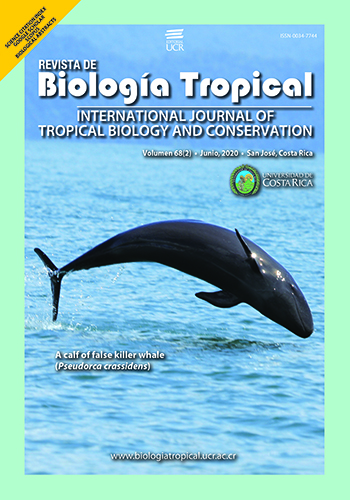Resumen
Introducción: Se utilizan quemas como parte del manejo de pastos introducidos en Chiapas, lo cual puede derivar en incendios forestales. Objetivos: obtener la carga de combustibles, comportamiento del fuego, emisiones de CO2 y derivar aspectos de seguridad durante el combate de incendios en pastizales y sabanas artificiales de pasto jaragua (Hyparrhenia rufa Nees.), debido a la falta de información sobre estos temas. Métodos: Se estudiaron un pastizal y una sabana, ambos de pasto jaragua, en las comunidades California y Flores Magón, respectivamente, en la Reserva de la Biosfera La Sepultura. Se midieron cargas de combustibles previos y posteriores a las quemas. Se condujeron seis quemas prescritas (tres a favor de viento y pendiente y tres en contra), en cada uno de los dos tipos de vegetación analizados, y se midieron variables meteorológicas, así como variables de comportamiento del fuego. Las emisiones se estimaron multiplicando la carga de combustibles consumida por una constante de emisión. Resultados: En el pastizal las medias fueron: carga inicial, 6.214 t/ha; carga residual, 0.107 t/ha, emisión de CO2, 10.449 t/ha. Para la sabana, los valores alcanzaron: 14.119, 2.161 y 20.460 t/ha, respectivamente, sin diferencias para las cargas previas y posteriores a la quema entre las quemas. Para el pastizal, las quemas a favor alcanzaron: 3.92 m, 1.83 m y 22.3 m/min para longitud y profundidad de llama y velocidad de propagación, mientras que tales valores para las quemas en contra, fueron: 1.07 m, 0.23 m y 0.67 m/min, con diferencias entre tipos de quema. Para la sabana, las quemas a favor alcanzaron 5.89 m (longitud de llama), 1.53 m (profundidad de llama) y 45.5 m/min (velocidad de propagación), mientras que para las quemas en contra tales valores fueron: 2.21 m, 0.76 m y 2.8 m/min, respectivamente. En todos los casos se reportan diferencias significativas. Conclusiones: El comportamiento del fuego, en particular en la sabana estudiada, es peligroso, por lo cual una buena prescripción y mucha precaución deben preverse durante quemas controladas o prescritas. Asimismo, un combate directo por el frente del fuego puede resultar muy peligroso, por lo cual debe evitarse y mejor combatir por la cola del incendio y esperar a que el frente avance en contra del viento y pendiente para combatirlo.
Citas
Aguirre-Muñoz, A., Mendoza-Alfaro, R., Arredondo-Ponce-Bernal, H., Arriaga-Cabrera, L., Campos-González, E., Contreras-Balderas, S., … Elías-Gutiérrez, M. (2009). Especies exóticas invasoras: impactos sobre las poblaciones de flora y fauna, los procesos ecológicos y la economía. En J. Sarukhán Kermes (coord. gral.). Capital Natural de México: Estado de conservación y tendencias de cambio (Vol. II, pp. 277-318). México: Conabio.
Alexander, M.E. (1982). Calculating and interpreting forest-fire intensities. Canadian Journal of Botany, 60, 349-357.
Aurell, J., B.K., & Gullett, D.T. (2015). Emissions from southeastern grasslands and pine savannas: Comparison of aerial and ground field measurements with laboratory burns. Atmospheric Environment, 111, 170-178.
Beerling, D.J., & Osborne, C.P. (2006). The origin of the savanna biome. Global Change Biology, 12, 2023-2031.
Bilbao, B., & Medina, E. (1996). Types of grassland fires and Nitrogen volatilization in tropical savannas of Calabozo, Venezuela. En J.S. Levine (coord.), Biomass Burning and Global Change (Vol. 2, pp. 569-574). Cambridge: The MIT Press.
Bogdan, A.V. (1997). Pastos Tropicales y Plantas de Forraje. México: AGT Editor.
Brown, J.K. (1974). Handbook for inventorying downed Woody material (Reporte Técnico General INT-16). Ogden, Utah: USDA Forest Service, Intermountain Forest Research Station.
Butler, B.W., Barlette, R.A., Bradshaw, L.S., Cohen, J.D., Andrews, P.L., Putnam, T., & Morgan, R.J. (1998). Fire behavior associated with the 1994 South Canyon Fire on Storm King Mountain, Colorado (Reporte RMRS-RP-9). Ogden, Utah: USDA Forest Service, Rocky Mountain Research Station.
Certini, G. (2005). Effects of fire on properties of forest soils: a review. Oecologia, 143, 1-10.
Chandler, C., Cheney, P., Thomas, P., Trabaud, L., & Williams, D. (1983). Fire in Forestry. (Vol. 1.) Forest Fire Behavior and Effects. New York: Wiley and Sons.
IPCC (Intergovernmental Panel of Climatic Change). (2001). Climate Change 2001: Impacts, Adaptation and Vulnerability. Cambridge, U. K.: Cambridge University Press.
Lesur, L. (2010). Manual de pasturas. México: Trillas.
Leiva, J.A., Rocha, O.J., Mata, R. & Gutiérrez-Soto, M.V. (2009). Cronología de la regeneración del bosque tropical seco en Santa Rosa, Guanacaste, Costa Rica. I. Características edáficas. Revista de Biología Tropical 57, 801-815.
Miranda, F. (2016). La Vegetación de Chiapas (Vol. 1). México: UNICACH.
Miranda, F., & Hernández-Xolocotzi, E. (2014). Los Tipos de Vegetación de México y su Clasificación. México: Sociedad Botánica de México, Conabio, FCE.
Rocha-Loredo, A.G., Ramírez-Marcial, N., & González Espinosa, M. (2010). Riqueza y diversidad de árboles del bosque tropical caducifolio en la depresión central de Chiapas. Boletín de la Sociedad Botánica de México, 87, 89-103.
Rodríguez-Trejo, D.A., & Sierra-Pineda, A. (1995). Evaluación de los combustibles forestales en los bosques el sur del Distrito Federal. Ciencia Forestal en México, 20, 193-218.
Scott, A.C., Bowman, D.M.J.S., Bond, W.J., Pyne, S.J., & Alexander, M.E. (2014). Fire on Earth. An Introduction. Singapore: Wiley Blackwell.
Secretaría de Medio Ambiente y Recursos Naturales [SEMARNAT]/Secretaría de Agricultura, Ganadería, Desarrollo Rural, Pesca y Alimentación [SAGARPA]. (2009). Norma Oficial Mexicana NOM-015-SEMARNAT/SAGARPA-2017. Diario oficial de la federación, 16 de enero de 2009, 23-91.
Villanueva Ávalos, J.F., Negrete-Ramos, L.F., Villalobos-González, J.C., & Britton, C.M. (2008). Respuesta de seis gramíneas tropicales a la quema prescrita en la costa oeste de México. Técnica Pecuaria en México, 46, 397-411.
Wade, D.D., & Lunsford, J.D. (1989). A guide for prescribed fire in southern forests. (Reporte técnico RS-TP 11). Atlanta: USDA Forest Service Southern Region.
##plugins.facebook.comentarios##

Esta obra está bajo una licencia internacional Creative Commons Atribución 4.0.
Derechos de autor 2020 Dante Arturo Rodríguez-Trejo, Pedro Martínez-Muñoz, Jorge Alberto Pulido-Luna, Pedro Jerónimo Martínez-Lara, José Domingo Cruz-López







